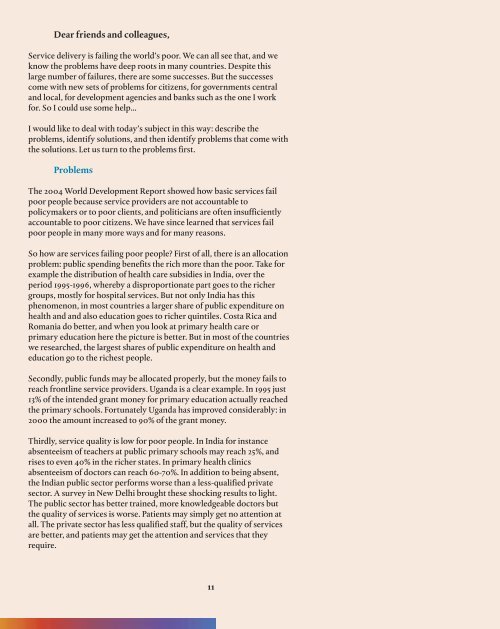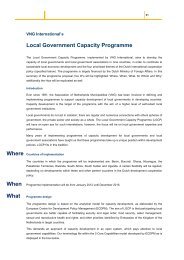Opmaak 1 - VNG International
Opmaak 1 - VNG International
Opmaak 1 - VNG International
Create successful ePaper yourself
Turn your PDF publications into a flip-book with our unique Google optimized e-Paper software.
Dear friends and colleagues,<br />
Service delivery is failing the world’s poor. We can all see that, and we<br />
know the problems have deep roots in many countries. Despite this<br />
large number of failures, there are some successes. But the successes<br />
come with new sets of problems for citizens, for governments central<br />
and local, for development agencies and banks such as the one I work<br />
for. So I could use some help...<br />
I would like to deal with today’s subject in this way: describe the<br />
problems, identify solutions, and then identify problems that come with<br />
the solutions. Let us turn to the problems first.<br />
Problems<br />
The 2004 World Development Report showed how basic services fail<br />
poor people because service providers are not accountable to<br />
policymakers or to poor clients, and politicians are often insufficiently<br />
accountable to poor citizens. We have since learned that services fail<br />
poor people in many more ways and for many reasons.<br />
So how are services failing poor people? First of all, there is an allocation<br />
problem: public spending benefits the rich more than the poor. Take for<br />
example the distribution of health care subsidies in India, over the<br />
period 1995-1996, whereby a disproportionate part goes to the richer<br />
groups, mostly for hospital services. But not only India has this<br />
phenomenon, in most countries a larger share of public expenditure on<br />
health and and also education goes to richer quintiles. Costa Rica and<br />
Romania do better, and when you look at primary health care or<br />
primary education here the picture is better. But in most of the countries<br />
we researched, the largest shares of public expenditure on health and<br />
education go to the richest people.<br />
Secondly, public funds may be allocated properly, but the money fails to<br />
reach frontline service providers. Uganda is a clear example. In 1995 just<br />
13% of the intended grant money for primary education actually reached<br />
the primary schools. Fortunately Uganda has improved considerably: in<br />
2000 the amount increased to 90% of the grant money.<br />
Thirdly, service quality is low for poor people. In India for instance<br />
absenteeism of teachers at public primary schools may reach 25%, and<br />
rises to even 40% in the richer states. In primary health clinics<br />
absenteeism of doctors can reach 60-70%. In addition to being absent,<br />
the Indian public sector performs worse than a less-qualified private<br />
sector. A survey in New Delhi brought these shocking results to light.<br />
The public sector has better trained, more knowledgeable doctors but<br />
the quality of services is worse. Patients may simply get no attention at<br />
all. The private sector has less qualified staff, but the quality of services<br />
are better, and patients may get the attention and services that they<br />
require.<br />
11

















